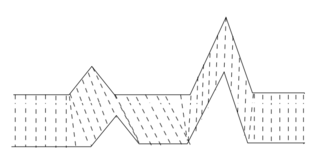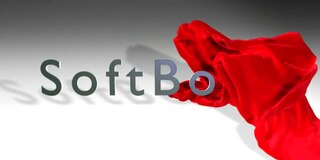Related Research Articles
Vector quantization (VQ) is a classical quantization technique from signal processing that allows the modeling of probability density functions by the distribution of prototype vectors. It was originally used for data compression. It works by dividing a large set of points (vectors) into groups having approximately the same number of points closest to them. Each group is represented by its centroid point, as in k-means and some other clustering algorithms.

Pattern recognition is the automated recognition of patterns and regularities in data. While similar, pattern recognition (PR) is not to be confused with pattern machines (PM) which may possess (PR) capabilities but their primary function is to distinguish and create emergent pattern. PR has applications in statistical data analysis, signal processing, image analysis, information retrieval, bioinformatics, data compression, computer graphics and machine learning. Pattern recognition has its origins in statistics and engineering; some modern approaches to pattern recognition include the use of machine learning, due to the increased availability of big data and a new abundance of processing power.

Image registration is the process of transforming different sets of data into one coordinate system. Data may be multiple photographs, data from different sensors, times, depths, or viewpoints. It is used in computer vision, medical imaging, military automatic target recognition, and compiling and analyzing images and data from satellites. Registration is necessary in order to be able to compare or integrate the data obtained from these different measurements.
In physics and materials science, elasticity is the ability of a body to resist a distorting influence and to return to its original size and shape when that influence or force is removed. Solid objects will deform when adequate loads are applied to them; if the material is elastic, the object will return to its initial shape and size after removal. This is in contrast to plasticity, in which the object fails to do so and instead remains in its deformed state.
Biometrics are body measurements and calculations related to human characteristics. Biometric authentication is used in computer science as a form of identification and access control. It is also used to identify individuals in groups that are under surveillance.

In time series analysis, dynamic time warping (DTW) is an algorithm for measuring similarity between two temporal sequences, which may vary in speed. For instance, similarities in walking could be detected using DTW, even if one person was walking faster than the other, or if there were accelerations and decelerations during the course of an observation. DTW has been applied to temporal sequences of video, audio, and graphics data — indeed, any data that can be turned into a one-dimensional sequence can be analyzed with DTW. A well-known application has been automatic speech recognition, to cope with different speaking speeds. Other applications include speaker recognition and online signature recognition. It can also be used in partial shape matching applications.
An elastic modulus is the unit of measurement of an object's or substance's resistance to being deformed elastically when a stress is applied to it.
Hemorheology, also spelled haemorheology, or blood rheology, is the study of flow properties of blood and its elements of plasma and cells. Proper tissue perfusion can occur only when blood's rheological properties are within certain levels. Alterations of these properties play significant roles in disease processes. Blood viscosity is determined by plasma viscosity, hematocrit and mechanical properties of red blood cells. Red blood cells have unique mechanical behavior, which can be discussed under the terms erythrocyte deformability and erythrocyte aggregation. Because of that, blood behaves as a non-Newtonian fluid. As such, the viscosity of blood varies with shear rate. Blood becomes less viscous at high shear rates like those experienced with increased flow such as during exercise or in peak-systole. Therefore, blood is a shear-thinning fluid. Contrarily, blood viscosity increases when shear rate goes down with increased vessel diameters or with low flow, such as downstream from an obstruction or in diastole. Blood viscosity also increases with increases in red cell aggregability.
Template matching is a technique in digital image processing for finding small parts of an image which match a template image. It can be used for quality control in manufacturing, navigation of mobile robots, or edge detection in images.

In materials science, work hardening, also known as strain hardening, is the strengthening of a metal or polymer by plastic deformation. Work hardening may be desirable, undesirable, or inconsequential, depending on the context.
Facial motion capture is the process of electronically converting the movements of a person's face into a digital database using cameras or laser scanners. This database may then be used to produce computer graphics (CG), computer animation for movies, games, or real-time avatars. Because the motion of CG characters is derived from the movements of real people, it results in a more realistic and nuanced computer character animation than if the animation were created manually.
In neuroimaging, spatial normalization is an image processing step, more specifically an image registration method. Human brains differ in size and shape, and one goal of spatial normalization is to deform human brain scans so one location in one subject's brain scan corresponds to the same location in another subject's brain scan.

Soft-body dynamics is a field of computer graphics that focuses on visually realistic physical simulations of the motion and properties of deformable objects. The applications are mostly in video games and films. Unlike in simulation of rigid bodies, the shape of soft bodies can change, meaning that the relative distance of two points on the object is not fixed. While the relative distances of points are not fixed, the body is expected to retain its shape to some degree. The scope of soft body dynamics is quite broad, including simulation of soft organic materials such as muscle, fat, hair and vegetation, as well as other deformable materials such as clothing and fabric. Generally, these methods only provide visually plausible emulations rather than accurate scientific/engineering simulations, though there is some crossover with scientific methods, particularly in the case of finite element simulations. Several physics engines currently provide software for soft-body simulation.
Interactive skeleton-driven simulation is a scientific computer simulation technique used to approximate realistic physical deformations of dynamic bodies in real-time. It involves using elastic dynamics and mathematical optimizations to decide the body-shapes during motion and interaction with forces. It has various applications within realistic simulations for medicine, 3D computer animation and virtual reality.
Thin plate splines (TPS) are a spline-based technique for data interpolation and smoothing. They were introduced to geometric design by Duchon. They are an important special case of a polyharmonic spline. Robust Point Matching (RPM) is a common extension and shortly known as the TPS-RPM algorithm.
Object recognition – technology in the field of computer vision for finding and identifying objects in an image or video sequence. Humans recognize a multitude of objects in images with little effort, despite the fact that the image of the objects may vary somewhat in different view points, in many different sizes and scales or even when they are translated or rotated. Objects can even be recognized when they are partially obstructed from view. This task is still a challenge for computer vision systems. Many approaches to the task have been implemented over multiple decades.
Part-based models refers to a broad class of detection algorithms used on images, in which various parts of the image are used separately in order to determine if and where an object of interest exists. Amongst these methods a very popular one is the constellation model which refers to those schemes which seek to detect a small number of features and their relative positions to then determine whether or not the object of interest is present.
Sayre's paradox is a dilemma encountered in the design of automated handwriting recognition systems. A standard statement of the paradox is that a cursively written word cannot be recognized without being segmented and cannot be segmented without being recognized. The paradox was first articulated in a 1973 publication by Kenneth M. Sayre, after whom it was named.
Computational anatomy is an interdisciplinary field of biology focused on quantitative investigation and modelling of anatomical shapes variability. It involves the development and application of mathematical, statistical and data-analytical methods for modelling and simulation of biological structures.
Large deformation diffeomorphic metric mapping (LDDMM) is a specific suite of algorithms used for diffeomorphic mapping and manipulating dense imagery based on diffeomorphic metric mapping within the academic discipline of computational anatomy, to be distinguished from its precursor based on diffeomorphic mapping. The distinction between the two is that diffeomorphic metric maps satisfy the property that the length associated to their flow away from the identity induces a metric on the group of diffeomorphisms, which in turn induces a metric on the orbit of shapes and forms within the field of Computational Anatomy. The study of shapes and forms with the metric of diffeomorphic metric mapping is called diffeomorphometry.
References
- ↑ Talmi, Itamar; Mechrez, Roey; Zelnik-Manor, Lihi (2016). "Template Matching with Deformable Diversity Similarity". arXiv: 1612.02190 [cs.CV].
- Uchida, Seiichi (August 2005). "A Survey of Elastic Matching Techniques for Handwritten Character Recognition" (PDF). IEICE Transactions on Information and Systems. E88-D (8): 1781–1790. Bibcode:2005IEITI..88.1781U. doi:10.1093/ietisy/e88-d.8.1781.